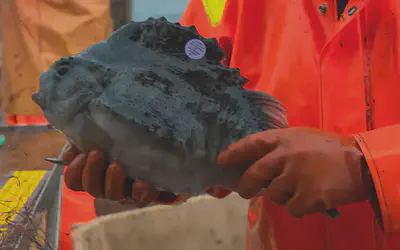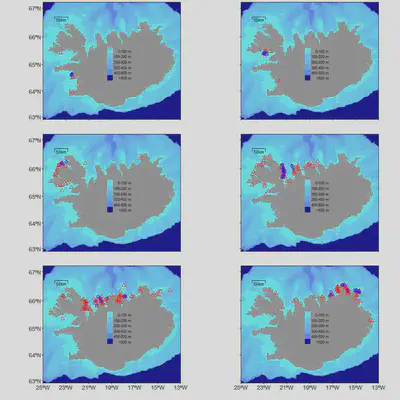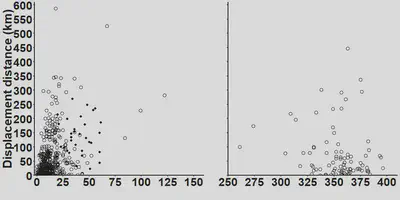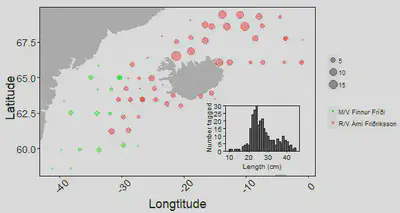Lumpfish tagging
As spring approaches in Iceland, lumpfish begin to migrate to the coast for spawning and at this time fishers get aboard their boats to begin laying their nets. But where did all these fish come from? do they stay in the local area after they have arrived or do they move around? and where will they go after spawning? These are some of the questions that were the focus when we started tagging lumpfish back in 2008. Over the course of the next ten years, scientists accompanied the lumpfish fishers (grásleppukarl) aboard their boats and tagged and released the fish which were caught (Figure 1).

The initial results from this study showed that lumpfish move around a lot more than expected (Figure 2). Many fish were recaptured close to where they were tagged but many traveled substantial distances with one fish recaptured 587 km from where it was tagged, The fastest swimmer was a fish which traveled 298 km in 6 days, 49 km per day. So it appears that lumpfish will move around Iceland after thy have reached the coastal area.

The majority of the recaptured fish were caught less than 150 days after they were tagged, i.e. in the same fishing season. However a small number (93) were captured in the following year, more than 300 days after recapture. Of these fish caught after 300 days, 50% were caught within 30km of where they were tagged and 75% within 80km (Figure 3). This suggests that lumpfish exhibit homing behaviour with the females returning to areas where they spawned previously. It is unclear if they are also returning to areas where they themselves were spawned.

We also tagged fish during the Iceland spring groundfish survey: this is a bottom trawl survey which takes place every year in February-March at depths from 50-500m. This was a trial to ensure that some of these fish would be recaptured in the fishery before we tagged them with Data Storage Tags, which are much more expensive. We tagged 143 fish (109 fish with Petersen disc tags and 34 with DST tags) with 38 fish recaptured which included 15 DST tags (Figure 4). We found a mixture of behaviours, some fish tagged close together would be recaptured large distances apart and two fish tagged at the same time were recaptured by the same fisher, one day apart.

In 2012, Iceland began participating in the International Ecosystem Survey of the Nordic Seas (IESSNS). This is a large pelagic survey which assess the abundance and distribution of mackerel (Scomber scombrus) and herring (Clupea harengus) across the Nordic Seas. It became apparent from this survey that juvenile lumpfish were distributed over a large area and their was a continuous distribution from the eastern coast of Greenland to Iceland and up to northern Norway. As we knew very little about the juvenile period of lumpfish, in collaboration with the Greenlandic Institute of Natural Resources, we began tagging the fish in 2018 in order to learn how fast the fish grew, how long do they spend in this area before migrating to coastal areas to spawn and also where do these fish go spawn, Iceland or Norway (Figure 5).
